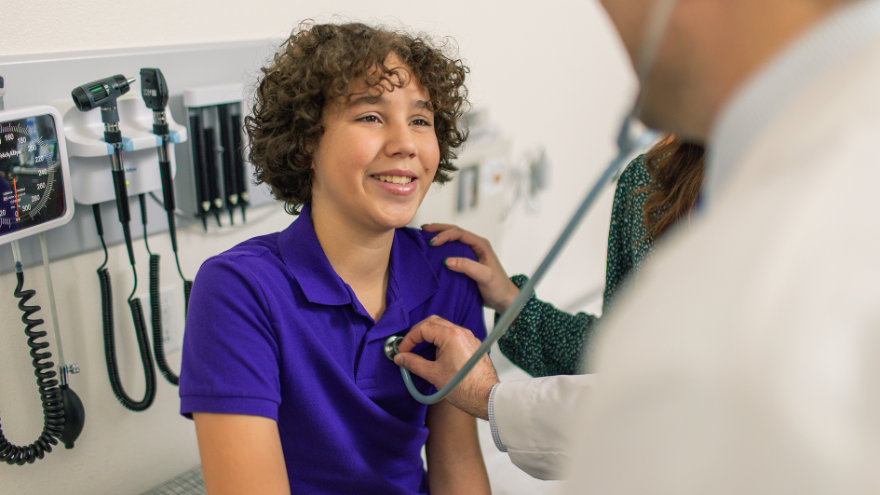Search
-
Importance of Well Child Visits
It’s important to establish children with a pediatrician so that their health baselines can be monitored regularly throughout each stage of their life, from infancy to young adulthood. Well-child visits are comprehensive, preventative check-ups that are vital to each child and teen’s overall health and wellbeing. At Renown Children’s Hospital, our Pediatric Primary Care team is dedicated to treating children with personalized medical care – we are focused on each child’s individualized healthcare needs, offering services ranging from well-child visits and immunizations to sports physicals, care for illnesses and minor injuries, mental health support and specialist referrals when needed. Here is an overview of the timeline and importance of well-child visits for you to reference as you care for your children. Well-Child Visit Schedule Renown Children’s Primary Care provides the following well-child visit schedule: Three to five days after birth 2 weeks Two months Four months Six months Nine months One year 15 months 18 months Two years, and yearly after
-
How to Get Your Kids to Sleep, Screen-Free
If you’re a parent, you’ve probably been there — the sometimes-nightly struggle to get your little ones off to bed. Elaina Lantrip, an APRN with Renown Pediatrics, offers some tips and explains how your child’s electronics may be getting in the way of a good night’s sleep. These days, kids are consuming media from a very early age on all types of devices — from tablets and phones to TVs. While they can benefit from some media use, it can have a negative impact on bedtime. We asked Elaina Lantrip, an advanced nurse practitioner with Renown Pediatrics, for some advice on downloading a better bedtime routine. What are the most important practices for parents to establish for their children’s bedtime routines? I often have parents tell me that their child won’t go to bed — or to sleep. Parents frequently ask for tips on bedtime routines that work. My first question is whether their regular bedtime routine involves television, iPad, tablet, phone or anything with a screen. It’s very important that bedtime includes a bath, reading a story, talking, singing and bonding with young ones, rather than using any devices. Why shouldn’t children have a device at bedtime? A growing body of research supports that screen time at bedtime contributes to delays in a child’s falling to sleep; overall inability to reach the important REM, or deep sleep; waking up during the night; nightmares and night terrors. For older youth, engaging with social media before bedtime can bring up stresses, emotions and relationship issues with peers that don’t exactly create peaceful bedtime thoughts. Bedtime should be a screen-free, stress-free, peaceful time of day. It’s a great time for parents to promote self-esteem, talk through things going on in the child’s life, to encourage and build them up. Children grow up fast — bedtime is a great the opportunity with younger children to cuddle up and read a story or sing a lullaby. What are other major considerations in making bedtime smooth and relaxing for kids and their parents? Another factor that contributes to positive sleep habits includes children getting enough activity during the the day so they’re genuinely tired at night. Also helpful are ambient noise makers, peaceful music, avoiding sugar two hours prior to bedtime, consistency in bedtime routine, comfortable pajamas and comfortable temperature in the home. Is it important to keep the child’s bedroom dark? Dimming the lights is important, regardless of the time of year. This is another reason to ban screens, as they emit light that stimulates wakefulness.
-
Teens and Social Media: When Is it Too Much?
Dr. Max J. Coppes, Physician-in-Chief Renown Children’s Hospital, and Nell J. Redfield Chair of Pediatrics, UNR Med, talks about how much is too much when it comes to teens and social media. Social apps (Facebook, Instagram, Twitter, WhatsApp, Snapchat, TikTok, etc.) have become an integral part of most people’s lives. In contrast to traditional media — where one source goes to many receivers — social media operates in a dialogic transmission system. Many sources interact, sometimes simultaneously, with many receivers and provide for superior interactivity between its users. Not surprisingly, it also plays a significant role in our children’s lives once they are old enough to understand how to access and use these apps. On average, children start exploring social media at around ages 10 to 12. They rapidly discover that electronic communication allows for unique and personalized ways to make and keep friendships. They also use it to develop and expand family ties, get help with homework, share music, art, and experiences, and learn and discover the world. Social Media and Teens Surveys suggest that more than 90 percent of teenagers use social media. Additionally, approximately 75 percent have at least one active profile by age 17. Access to social media is greatly facilitated because more than two-thirds of teens have their own mobile devices with internet capabilities, a substantial change relative to previous generations. The use of social apps can have many positive aspects. But we now also recognize that it can also have negative impacts. The use of hazardous sites or the inherent risks of using social media (identity theft, being hacked, cyber-bullying, etc.) are indeed damaging to children. Any use of hazardous social apps is too much and carries serious hazards. But what about the use of “normal” and/or “safe” social media? Well, data suggest that too much use of “non-hazardous” apps can indeed affect health. How Much Do Teens Use Social Media? First, some basic data. For example, how much do normal teenagers use social media? A study from Pew Research found that more than 50 percent of 13- to 17 year-olds go online several times a day. This quickly increases during the teenage years to more than 70 minutes per day. Teenage girls have the highest usage at just over 140 minutes per day. It is important to recognize that non-school related use of the internet and social media is often beheld by teenagers as important for developing their self-esteem, their acceptance among peers, and their mental health in general. As parents, we recognize that the use of social media can indeed contribute, in many positive ways, to our children’s growth. At the same time, we also worry about them spending too much time online. We worry about their ability to communicate effectively in face-to-face settings or in writing. Many of us also feel and/or worry that our children are addicted. Social Media and Addiction Recent studies suggests that the overuse of social media indeed mirrors addiction. Reports now show that teenagers and college kids experience anxiety when deprived from their connected devices and consequently feel a compulsion to access their social applications. The emotional symptoms they experience are very similar to those seen in substance abuse. In fact, the American Psychiatric Association is considering making internet addition a bonafide diagnosis. Pediatricians therefore encourage limits on the use of social media, a recommendation more easily suggested than accomplished. So when should a parent consider seeking help? Aside from unhealthy use of these apps (cyber-bullying, sexting, online users asking for sexual relations, etc.), which should always trigger concern, the use of social media for more than 120 minutes per day should trigger parental concern. If you feel unable to address the overuse of social media, contact your pediatrician for help and guidance. Renown Children’s Hospital Whether it’s seeing a pediatrician, getting a sports physical or looking for advice, our care is centered around supporting and nurturing patients and families at our many locations. We have pediatricians dedicated to children who have experience recognizing children’s illnesses. They also have knowledge about tests and treatments for young ones to ensure your child gets the best care possible. Explore Children’s Services
Read More About Teens and Social Media: When Is it Too Much?
-
Early Onset of Puberty in Girls on the Rise
Many factors are contributing to the rise of early onset puberty in girls. Learn what they are below and how you can support your daughter. The number of girls experiencing early puberty has increased dramatically over the last few years and continues to grow. More and more girls in the U.S. are starting to show signs of development before the age of 8. Recent studies show that up to 10 percent of Caucasian girls and 23 percent of African American girls are showing signs of puberty by age 7. What’s Contributing to Early Puberty in Girls? Determining the exact cause is difficult. But experts agree that several factors may be contributing to these growing numbers. Increasing rates of childhood overweight and obesity. Excess body fat alters the levels of hormones responsible for the acceleration of pubertal timing. Physical inactivity may decrease melatonin levels, which can also trigger pubertal development. Increased animal protein intake. Higher total protein, animal protein and meat intake in children ages 3 to 7 have been associated with earlier onset of menstruation. High protein intake elevates IGF-1 levels and promotes growth, which could accelerate the onset of puberty. Poor diet. Children with lower-nutrient diets tend to enter puberty earlier. A diet rich in processed foods and meats, dairy, and fast food is disruptive to normal physical development. Exposure to EDCs (endocrine-disrupting chemicals). EDCs are synthetic chemicals found in plastics, pesticides, fuels and other industrial chemicals that inhibit or alter the action of natural hormones. Because EDCs accumulate in the fatty tissues of animals, animal foods contain higher levels of these chemicals than plant foods. Exposure to BPA (bisphenol A). BPA is an industrial petrochemical found in a variety of products including plastics, tin-can linings and even cash register receipts. Because it acts as a synthetic estrogen it may speed up pubertal development. Soy products. Soy contain isoflavones which are converted to phytoestregens in the body, and are similar to the hormone estrogen, Dr. Chelsea Wicks says. “Soy consumed from natural food sources is likely safe and will not cause abnormal hormones levels. However, when consumed in large amounts, such as with soy supplements or in more processed foods, there have been links to chronic medical problems due to elevated estrogen levels. I feel a good answer to this is to continue working on eating fresh foods and trying to avoid the processed, packaged foods as this will be best for overall general nutrition as well,” she adds. What You Can Do While some genetic factors play a role in the early onset of puberty, parents can help lessen environmental causes of the condition. Encourage and help your child to maintain a healthy weight with proper nutrition and exercise. Avoid exposure to hormones such as estrogen and testosterone that may be found in hair products, medications and nutritional supplements. Avoid exposure to EDCs and BPA. Offer your child a diet centered around whole plant foods rather than animal foods, which will help keep protein intake within a safe range and reduce consumption of EDCs. Create a supportive environment for your daughter. Avoid commenting on her appearance and instead focus on her achievements, academic successes or artistic talents. Speak to her openly and honestly about the physical changes she’s experiencing — that although these changes are normal, she’s simply developing early — and that ultimately her peers will undergo the same changes. Encourage your daughter to continue participating in social activities and pursuing her interests, and reassure her you are always open to discuss any questions or worries. If you are concerned that your child may be going through these changes before expected, speak with your pediatrician. Sources: Early Puberty: Causes and Consequences When Is Puberty Too Early? Precocious Puberty (Early Puberty) Precocious Puberty



